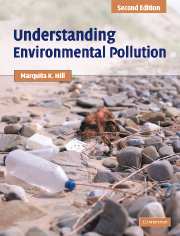Book contents
- Frontmatter
- Contents
- Preface
- Acknowledgements
- List of abbreviations and acronyms
- Chapter 1 Understanding pollution
- Chapter 2 Reducing pollution
- Chapter 3 Chemical toxicity
- Chapter 4 Chemical exposures and risk assessment
- Chapter 5 Air pollution
- Chapter 6 Acidic deposition
- Chapter 7 Global climate change
- Chapter 8 Stratospheric-ozone depletion
- Chapter 9 Water pollution
- Chapter 10 Drinking-water pollution
- Chapter 11 Solid waste
- Chapter 12 Hazardous waste
- Chapter 13 Energy
- Chapter 14 Persistent, bioaccumulative, and toxic
- Chapter 15 Metals
- Chapter 16 Pesticides
- Chapter 17 Pollution at home
- Chapter 18 Zero waste, zero emissions
- Index
- References
Chapter 14 - Persistent, bioaccumulative, and toxic
- Frontmatter
- Contents
- Preface
- Acknowledgements
- List of abbreviations and acronyms
- Chapter 1 Understanding pollution
- Chapter 2 Reducing pollution
- Chapter 3 Chemical toxicity
- Chapter 4 Chemical exposures and risk assessment
- Chapter 5 Air pollution
- Chapter 6 Acidic deposition
- Chapter 7 Global climate change
- Chapter 8 Stratospheric-ozone depletion
- Chapter 9 Water pollution
- Chapter 10 Drinking-water pollution
- Chapter 11 Solid waste
- Chapter 12 Hazardous waste
- Chapter 13 Energy
- Chapter 14 Persistent, bioaccumulative, and toxic
- Chapter 15 Metals
- Chapter 16 Pesticides
- Chapter 17 Pollution at home
- Chapter 18 Zero waste, zero emissions
- Index
- References
Summary
Sustainable development simply means “treating the earth as if we intended to stay.”
(Crispin Tickell, British Ambassador to the United Nations)One chemical category poses special concerns: the persistent, bioaccumulative, and toxic (PBT) chemicals. These chemicals also often move among air, water, and land, and cross human boundaries. Section I of this chapter examines general characteristics of PBTs. We see that even at low levels, PBTs can present problems. Section II examines three families of PBTs that are organic chemicals: polychlorinated, polybrominated, and polyfluorinated PBTs. Metal PBTs are discussed in Chapter 15.
SECTION I
About 87 000 chemicals are in commercial use. The US Environmental Protection Agency (a US agency) has identified 53 of these as persistent, bioaccumulative, and toxic (PBT). Of these, 42 are organic chemicals, many polychlorinated. The other eleven are metals. Doubtless others will be identified as additional chemicals are screened. To identify only 53 among 87 000 may seem a small number, but given their potential to cause problems we can be grateful for this relatively small number. Moreover, other chemicals, such as the polychlorinated biphenyls (PCBs), would be classified as PBTs were they still manufactured today. Industrialized countries banned the worst polychlorinated chemicals in the 1970s and 1980s, long enough ago that even though they are persistent, environmental levels have fallen. However, hot spots remain and people are advised not to eat fish caught in the Great Lakes and certain other areas.
- Type
- Chapter
- Information
- Understanding Environmental PollutionA Primer, pp. 339 - 349Publisher: Cambridge University PressPrint publication year: 2004

